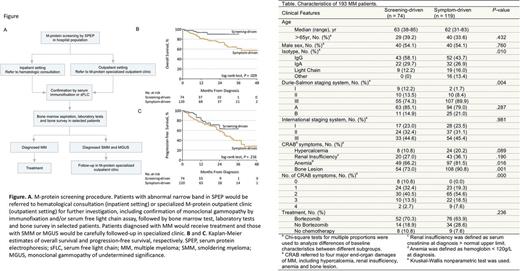Abstract
Introduction:
The annual incidence of MM in China is 0.6/100,000, much lower than that in United States (6.6/100,000). Despite ethnic disparities and hereditary distinction, the difference in incidence between China and US may also be attributed to unscientific health-seeking behavior that Chinese people are less likely to receive routine body examination and often delay seeking health service. Furthermore, primary care physicians in China often lack awareness of early signs of myeloma. Therefore, most myeloma patients in China were diagnosed and treated only until severe complications occurred, with 85.8% of patients staged as Durie-Salmon stage III at diagnosis. Meanwhile, Chinese myeloma patients suffer from an inferior outcome, with a median overall-survival of only 4.5 year.
In Zhongshan Hospital, Fudan University, a large national reference center in Shanghai delivering medical service for over 3,400,000 patients annually, serum protein electrophoresis (SPEP) is routinely incorporated into liver biochemical and function tests, and therefore providing us unique opportunities to observe the prevalence of monoclonal gammopathy in a hospital population, to screen and identify patients with myeloma or other monoclonal immunoglobulins (M-protein) related disorders at earlier stage, and to evaluate the impact of M-protein screening on baseline characteristics and outcome of patients with MM.
Methods:
Given every patient receiving liver biochemical tests were routinely screened for M-protein by SPEP in our institute, we initiated a standardized M-protein screening procedure based on SPEP screening in hospital population (Figure Panel A),
In this retrospective cohort study, we examined records of hospitalized newly diagnosed MM patients with complete data from January 2013 to December 2016. MM patients with concurrent cardiac amyloidosis were excluded due to distinct prognosis. Patients were categorized by the means of detection of the disease. Patients were considered in screening-driven group if they had an incidental finding of M-protein during workup of unrelated medical conditions and had a visit with hematologist in M-protein specialized clinic or during consultation. Symptom-driven group included patients visited or were referred to hematologic department due to suspected myeloma-related end-organ damage. Baseline characteristics, treatment, overall survival (OS) and progression-free survival (PFS) were compared. Institutional ethics committee approved the study and informed consent was waived.
All tests were 2-sided (SPSS version 21.0 was used) and a P -value < 0.05 was considered statistically significant.
Results:
We identified 193 eligible MM patients. The Table summarizes the baseline features. Compared to symptom-driven group, patients in screening-driven group had earlier DS stage disease (DS III 74.3% vs 89.9%, P= .004), lower frequency of anemia (66.2% vs 81.5, P= .016) and bone lesion (73.0%vs 90.8%, P= .001), and lesser number CRAB symptoms (P= .000).
The Figure (panel B and C) depicts survival of MM patients. Patients diagnosed via M-protein screening demonstrated significantly (HR 0.358, 95% CI, 0.138-0.932; P= .035) better outcome (2-yr OS, 89.9%; 95% CI, 75.9%-95.9%) than those in symptom-driven subgroup (2-yr OS, 73.1%; 95% CI, 62.2%-81.3%; HR 1) after adjusted for age, gender, treatment and number of CRAB symptoms with a Cox proportional hazards model.
Discussion:
Although M-protein screening in normal population is not currently recommended, the impact of myeloma screening in hospital population has not been studied. This very first report reveals increased detection of early stage myeloma and remarkable survival improvement resulted by M-protein screening in hospital population in China. Early detection and prolonged survival implies improvement in health-related Quality of Life and more opportunities to receive further lines of treatment when disease relapses, which is critical for Chinese MM patients, given that most of them were diagnosed and treated only after severe complications developed. Moreover, our data suggests that shortening the time between initial occurrence of end-organ damage and myeloma-targeted treatment by early detection may lead to better outcome.
Limitations of this report include its retrospective observational design, relying on data from a single center, and relatively insufficient follow-up.
No relevant conflicts of interest to declare.
Author notes
Asterisk with author names denotes non-ASH members.


This feature is available to Subscribers Only
Sign In or Create an Account Close Modal